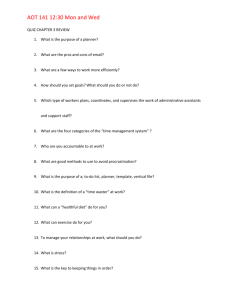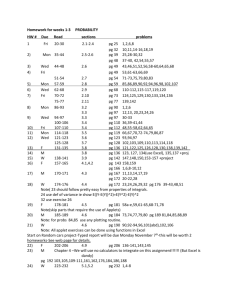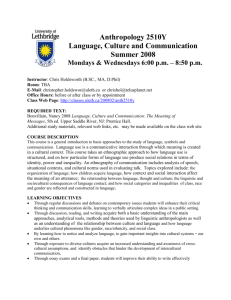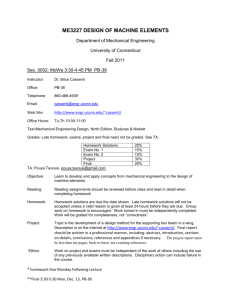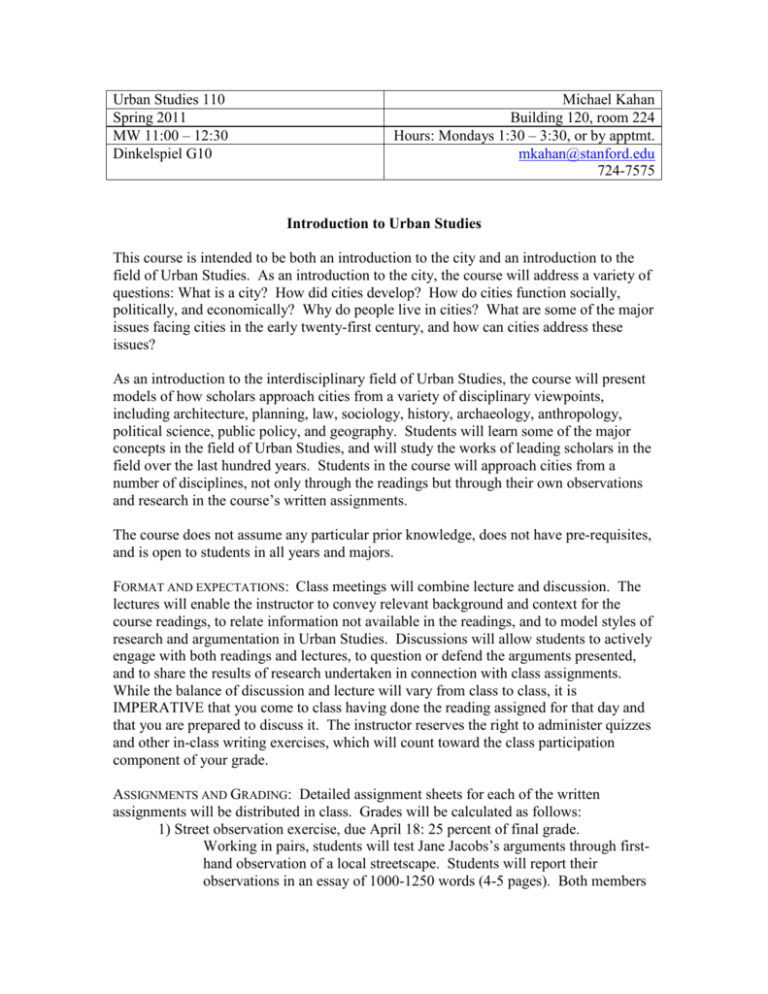
Urban Studies 110
Spring 2011
MW 11:00 – 12:30
Dinkelspiel G10
Michael Kahan
Building 120, room 224
Hours: Mondays 1:30 – 3:30, or by apptmt.
mkahan@stanford.edu
724-7575
Introduction to Urban Studies
This course is intended to be both an introduction to the city and an introduction to the
field of Urban Studies. As an introduction to the city, the course will address a variety of
questions: What is a city? How did cities develop? How do cities function socially,
politically, and economically? Why do people live in cities? What are some of the major
issues facing cities in the early twenty-first century, and how can cities address these
issues?
As an introduction to the interdisciplinary field of Urban Studies, the course will present
models of how scholars approach cities from a variety of disciplinary viewpoints,
including architecture, planning, law, sociology, history, archaeology, anthropology,
political science, public policy, and geography. Students will learn some of the major
concepts in the field of Urban Studies, and will study the works of leading scholars in the
field over the last hundred years. Students in the course will approach cities from a
number of disciplines, not only through the readings but through their own observations
and research in the course’s written assignments.
The course does not assume any particular prior knowledge, does not have pre-requisites,
and is open to students in all years and majors.
FORMAT AND EXPECTATIONS: Class meetings will combine lecture and discussion. The
lectures will enable the instructor to convey relevant background and context for the
course readings, to relate information not available in the readings, and to model styles of
research and argumentation in Urban Studies. Discussions will allow students to actively
engage with both readings and lectures, to question or defend the arguments presented,
and to share the results of research undertaken in connection with class assignments.
While the balance of discussion and lecture will vary from class to class, it is
IMPERATIVE that you come to class having done the reading assigned for that day and
that you are prepared to discuss it. The instructor reserves the right to administer quizzes
and other in-class writing exercises, which will count toward the class participation
component of your grade.
ASSIGNMENTS AND GRADING: Detailed assignment sheets for each of the written
assignments will be distributed in class. Grades will be calculated as follows:
1) Street observation exercise, due April 18: 25 percent of final grade.
Working in pairs, students will test Jane Jacobs’s arguments through firsthand observation of a local streetscape. Students will report their
observations in an essay of 1000-1250 words (4-5 pages). Both members
2
of each pair will normally receive the same grade, based on the joint work
that they turn in; however, the instructor will also read individual notes for
the assignment, and reserves the right to reduce the grade of a noncontributing partner.
2) Analysis of readings in Unit II, due May 9: 30 percent.
Working individually, each student will analyze readings from unit II in an
essay of no more than 1250 words.
3) Policy Recommendation, due June 1: 35 percent.
Working individually, each student will research a problem facing cities
today, and a policy to address that problem, and present the results in an
essay of no more than 2000 words. Students will also prepare a brief oral
presentation for class on June 1 summarizing their findings.
4) Class participation: 10 percent.
Students are expected to be in class on time and prepared to participate.
Participation in class discussion, contributions to online forums, and
performance on in-class writing assignments and pop quizzes are among
the methods the instructor may use to assess participation.
LAPTOP POLICY: Laptops may be used in class ONLY for two purposes: taking notes, and
referring to readings that are available on Courseworks. Using them for other purposes is
distracting to you AND those around you. Violating this policy will result in a drastic
reduction of your class participation grade.
COMMUNICATIONS: This course is registered in Coursework
(http://coursework.Stanford.edu). In Coursework you can see the syllabus,
announcements, and copies of assignments. The instructor will also use e-mail to
communicate with students; please check your mail regularly.
HONOR CODE: Students are expected to adhere as a matter of course to Stanford’s honor
code, which explicitly prohibits plagiarism. According to the Office of Judicial Affairs
(OJA) website, “For purposes of the Stanford University Honor Code, plagiarism is
defined as the use, without giving reasonable and appropriate credit to or acknowledging
the author or source, of another person’s original work, whether such work is made up of
code, formulas, ideas, language, research, strategies, writing or other form(s).” For
further information on avoiding plagiarism, please consult the OJA website:
http://www.stanford.edu/dept/vpsa/judicialaffairs/students/plagiarism.sources.htm
STUDENTS WITH DOCUMENTED DISABILITIES: Students who may need an academic
accommodation based on the impact of a disability must initiate the request with the
Student Disability Resource Center (SDRC) located within the Office of Accessible
Education (OAE). SDRC staff will evaluate the request with required documentation,
recommend reasonable accommodations, and prepare an Accommodation Letter for
faculty dated in the current quarter in which the request is being made. Students should
contact the SDRC as soon as possible since timely notice is needed to coordinate
accommodations. The OAE is located at 563 Salvatierra Walk (phone: 723-1066, 7231067 TTY).
3
READINGS: The following books for the course are available for purchase at the Stanford
Book Store, in the Urban Studies section. They are usually available used at a discount.
The course books will also be placed on reserve in Green Library.
Jane Jacobs, The Death and Life of Great American Cities (New York: Vintage
Books, 1992 [1961])
Mark Abrahamson, Global Cities (New York: Oxford University Press, 2004)
The remaining readings will be available on the Courseworks site. Please bring readings
with you to class the day they are due so that you can refer to them during discussions.
You may find it easier to print out online readings than to refer to them on the screen.
COURSE OUTLINE:
Mon. March 28: Introduction.
Unit I: Public Spaces and Neighborhoods: How do cities shape the way(s) we live
together?
Wed. March 30: Streets and Urban Planning Traditions.
Jane Jacobs, Death and Life, pp. 3-88.
Lewis Mumford, “Home Remedies for Urban Cancer,” in The Urban Prospect (New
York: Harcourt, Brace & World, 1968), pp. 182-207.
Mon. April 4: Uses of Streets and Public Space.
Jane Jacobs, Death and Life, pp. 141-221.
Wed. April 6: Public Space Today.
Mike Davis, “Fortress Los Angeles: The Militarization of Public Space,” in Variations on
a Theme Park: The New American City and the End of Public Space, ed. Michael
Sorkin (New York: Hill and Wang, 1992), pp. 154-180, 245-246.
Richard Ingersoll, “The Death of the Street: The Automobile and Houston,” in Roadside
America: The Automobile in Design and Culture, ed. Jan Jennings (Ames, Iowa:
Iowa State University Press, 1990), pp. 149-156.
Anthony Orum et al., “Public Man and Public Space in Shanghai Today,” City and
Community 8:4 (December 2009), 369-389.
Thursday, April 7 (optional): Film and Discussion: "Serious Play: The Worlds of Helen
Levitt" 6:00 PM, Cantor Arts Center; Public tour also available, 12:15 pm.
Friday, April 8 (optional): Private guided tour of “Paths Through the Global City” and
“In a New York Minute,” exhibits of urban photography, Cantor Arts Center, 11
AM.
4
Mon. April 11: Space and Community.
Louis Wirth, “Urbanism as a Way of Life,” American Journal of Sociology 44:1 (1938):
1-24.
Elijah Anderson, “The Cosmopolitan Canopy,” Annals of the American Academy of
Political and Social Science, Vol. 595, Being Here and Being There: Fieldwork
Encounters and Ethnographic Discoveries (Sep., 2004), pp. 14-31.
Gerald E. Frug, “Community Building,” ch. 6 in City Making: Building Communities
without Building Walls (Princeton: Princeton University Press, 1999), 115-142,
236-239.
Charter of The New Urbanism
Unit II: The City: How has it changed over time?
Wed. April 13 Urban Origins (Guest Lecturer: Ian Hodder, Anthropology)
V. Gordon Childe, “The Urban Revolution,” Town Planning Review 21:1 (April 1950):
3-17.
Michael Balter, “Why Settle Down? The Mystery of Communities,” Science 282: 5393
(Nov. 20, 1998): 1442-45.
Ian Hodder, “Women and Men at Çatalhöyük,” Scientific American, December 15, 2003.
Mon. April 18: Assignment 1 due in class. We will discuss our findings.
Wed. April 20: The Ancient City (Guest Lecturer: Jennifer Trimble, Classics)
Peter Hall, “The Fountainhead: Athens 500-400 BC,” and “The Imperial Capital: Rome
50 BC – AD 100,” in Cities in Civilization: Culture, Innovation, and Urban Order
(London: Weidenfeld & Nicolson, 1998): 24-68, 621-656, 991-995, 1027 - 1029
Mon. April 25: Ideal (and Real) Cities of the Renaissance (Guest Lecturer: Paula Findlen,
History)
Peter Hall, “The Rediscovery of Life: Florence 1400 – 1500,” Cities and Civilization 69113, 995-997.
Peter Clark, chapter 2, “Urban Trends 400 – 1500,” and chapter 7, “Urban Trends 1500 –
1800,” in European Cities and Towns, 400-2000 (Oxford: Oxford University
Press, 2009), 21-42, 109 – 138.
Wed. April 27: Industrial Cities
Friedrich Engels, “The Great Towns” (Selections), from The Condition of the Working
Class in England [1845], ed. David McLellan (Oxford: Oxford University Press,
1993), 36-39, 57-69, 85-86.
Douglas Rae, “Industrial Convergence on a New England Town,” chapter 2 in City:
Urbanism and Its End (New Haven: Yale University Press, 2003), 35-72, 440445.
5
Mon. May 2: Post Industrial Cities and the “New” Urban Poverty
Thomas Sugrue, “’The Damning Mark of False Prosperities’: The Deindustrialization of
Detroit,” chapter 5 in The Origins of the Urban Crisis: Race and Inequality in
Postwar Detroit (Princeton: Princeton University Press, 1996), 122-152, 317-324.
William Julius Wilson, “From Institutional to Jobless Ghettos,” and “Societal Changes
and Vulnerable Neighborhoods,” chapters 1 and 2 in When Work Disappears: The
World of the New Urban Poor (New York: Vintage Books, 1996), 3-50, 254-65.
Wed. May 4: The Growth of Suburbs and Sunbelt Cities
Kenneth Jackson, “Federal Subsidy and the Suburban Dream: How Washington Changed
the American Housing Market,” chapter 11 in Crabgrass Frontier: The
Suburbanization of the United States (New York: Oxford University Press, 1985),
190 – 218, 360 – 366.
Arizona State University Research Team, “Phoenix: Dealing with Fast Growth,” chapter
5 in Janet Rothenberg Pack, ed., Sunbelt / Frostbelt: Public Policies and Market
Forces in Metropolitan Development (Washington, D.C.: Brookings Institution
Press, 2005), 140 – 181.
Fri. May 6: Assignment 2 due by 12:30. Please submit to instructor’s mailbox in 120160.
Unit III: Global Challenges, Local Responses: Cities Today and Tomorrow
Mon. May 9: Global Cities I: People and Economies.
Mark Abrahamson, Global Cities (New York: Oxford University Press, 2004), chapters
1, 2, and 4.
Wed. May 11: Global Cities II: Migration and Inequality.
Abrahamson, chapters 3, 5, and 8.
Additional readings TBA.
Mon. May 16: Urban Sustainability I: Cities and Nature
Jane Jacobs, Death and Life, chapter 22.
David Owen, "Green Manhattan." The New Yorker 18 Oct. 2004: 111
Eric Klinenberg, Prologue: “The Urban Inferno” and chapter 2, “Race, Place, and
Vulnerability: Urban Neighborhoods and the Ecology of Support” in Heat Wave:
A Social Autopsy of Disaster in Chicago (Chicago: University of Chicago Press,
2002), 1-13, 79-128.
Wed. May 18: Urban Sustainability II: Cities and the Climate Crisis. (Guest Lecturer:
Rohit Aggarwala, Former Director, New York City Mayor's Office of Long-Term
Planning and Sustainability)
City of New York, “Introduction” and “Climate Change,” pp. 3-13 and 130-141 in
PlaNYC: A Greener, Greater New York (City of New York, 2007)
Lisa Benton-Short and John Rennie Short, chapter 12, “Sustainable Urban
Development,” in Cities and Nature (New York: Routledge, 2008), 223 - 256
6
Mon May 23: Urban Futures: Local, Regional, Federal Policies
Peter Dreier et al., chapters 6-7, “What Cities Can and Cannot Do to Address Poverty”
and “Regionalisms Old and New” in Place Matters: Metropolitics for the TwentyFirst Century (Lawrence: University Press of Kansas, 2001), 133-200 and 296322.
Bruce Katz, “Obama’s Metro Presidency,” City and Community 9:1 (March 2010), 2331.
Wed. May 25: Urban Futures from the Bottom Up
Alexander von Hoffman, “New Immigrants Transform the Old City,” chapter 6 in House
by House, Block by Block: The Rebirth of America’s Urban Neighborhoods
(Oxford: Oxford University Press, 2003), 206 – 249
Elizabeth Royte, “Street Farmer,” New York Times July 5, 2009
Paul Tough, “The Harlem Project,” New York Times Magazine, June 20, 2004.
Mon. May 31: No Class (Memorial Day).
Wed. June 1: Urban Futures / Urban Solutions. Final assignment due in class.
Syllabus copyright © 2011 Michael Kahan. All rights reserved.
Permission to copy and use under "fair use" in education is granted, provided proper credit is given.
Citation: Michael Kahan. Syllabus. Introduction to Urban Studies. University of Pennsylvania,
Spring 2011. H-Urban Teaching Center, H-Net. August 2012.
URL: http://www.h-net.org/~urban/teach/syllabi/kahan2011syl4.pdf


